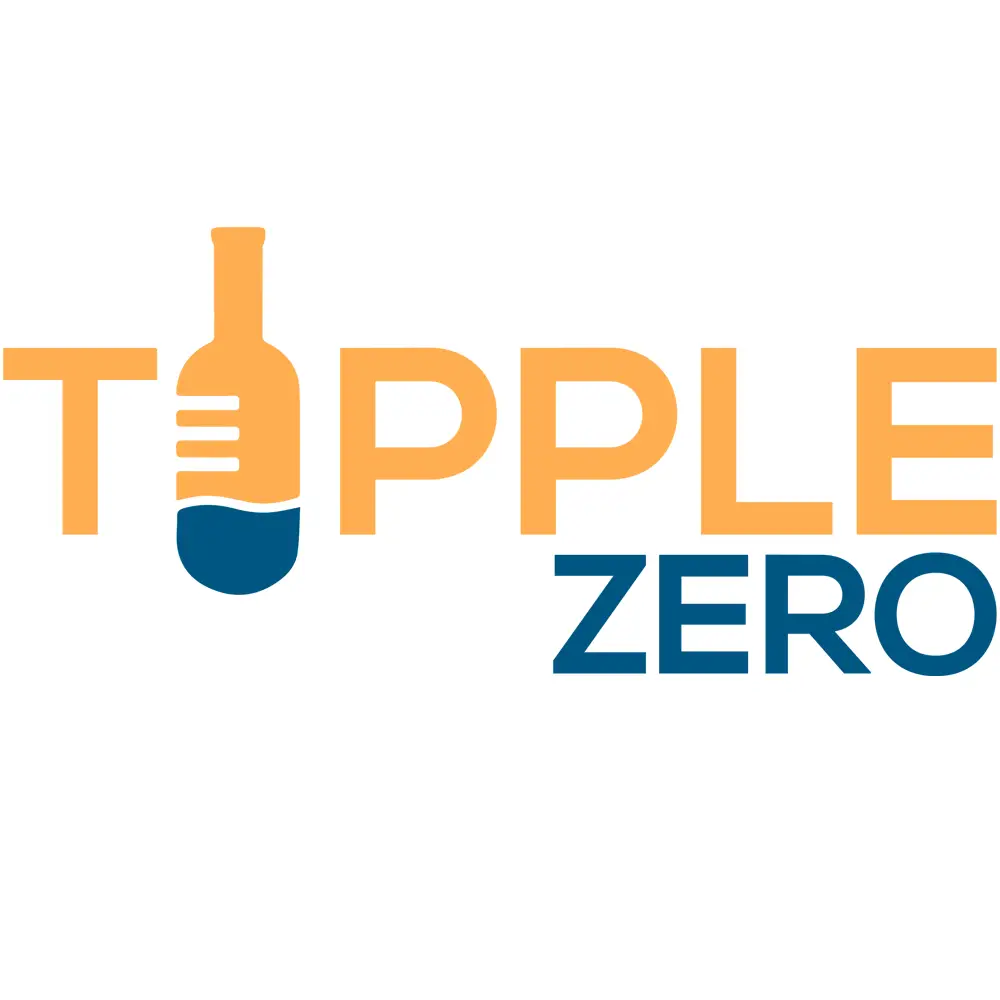While I’m sitting here drinking a glass of non-alcoholic pinot, I was thinking to myself does non-alcoholic wine have sugar in it? So I decided to go down the rabbit hole and do a bit of research and look into the levels of sugar between a few non-alcoholic wines compared to alcoholic wines to find out.
In general, non-alcoholic wine will often have more sugar in each glass when compared to alcoholic wine. This is usually because non-alcoholic wine is made with wine that has had the alcohol removed before being blended with a grape juice to build out the flavour profile. This will naturally add some extra natural sugar to each bottle.
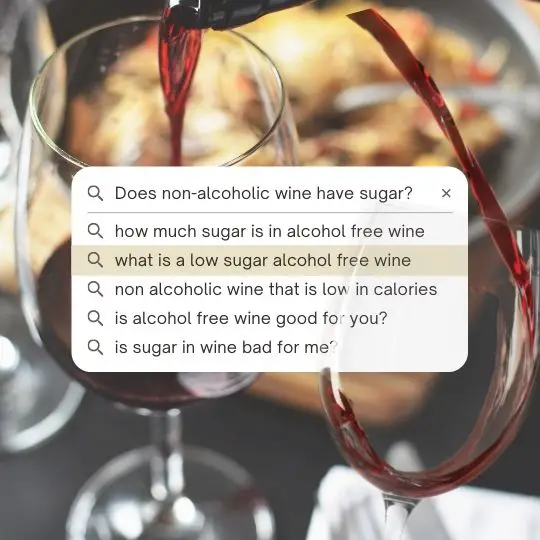
Why does non-alcoholic wine have sugar in it?
Putting the added grape juice to one side, to figure out why sugar has a place in non-alcoholic wine, we need to look at how non-alcoholic wine is made.
But before we look at the question of what is residual sugar – let’s run through the table of some of the most popular non-alcoholic wines on the market and review their sugar content. This way we’ll have context for the rest of the post.
What is the best low sugar non-alcoholic wine?
If you’re looking for a favourite low sugar non-alcoholic wine. I have listed out a couple in the 0 gram to 4 gram per 100ml range for you to look into and try out below.
Giesen 0% Sauv Blanc: Buy a Bottle | Read the Review
First place goes to the Giesen Sauvignon Blanc, with ultra-low sugar (1.8g per 100ml) and a really well-balanced profile it is one I regularly buy. It often sells out quickly so if you can get your hands on a bottle – do it fast!
Funky Monkey Pinot: Buy a Bottle | Read the Review
Next up is the Funky Monkey Pinot with its notes of cherry, dark red berries and profile rounding earthy notes it comes in at just 2.1g of sugar per 100ml. This one also flies off the shelf so get a bottle ASAP if you find it in stock.
Vinada Zero Alcohol Chardonnay: Buy a Bottle | Read the Review
Finally rounding out my top 3, is the Vinada Sparkling Chardonnay. Dry, Crisp and fruity, it comes in at 4 grams of sugar and 18 calories per 100ml. So a great low sugar sparkling option.
How much sugar is in non-alcoholic wine?
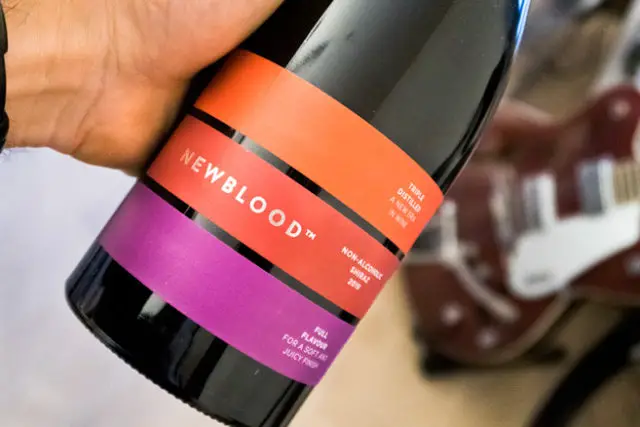
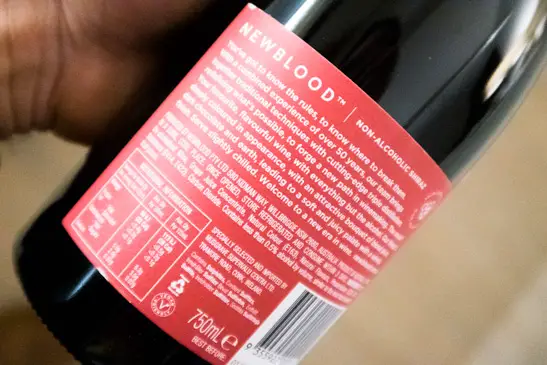
To save you from trudging through the ‘best sellers list’ of available non-alcoholic wines I’ve put together a table of top sellers and some up and coming drinks to show you sugar and calories per 100ml.
Take a look through the table at the bottom of this post for the full rundown with links to each product, but for now – the facts I found from my own research are all below:
- The overall sugar level in non-alcoholic / alcohol-free wine is low even for sparkling wines – see the Vinada Sparkling Chardonnay;
- non alcoholic wine of all types usually contains less than 4g of sugar per 100ml
- most non-alcoholic wines researched were below that 20 calories per 100ml level; and
- Compared to Alcoholic Wine, Non-alcoholic Wine may have more sugar due to the way flavour profiles are built things like grape juice.
So to understand that last point a bit better, why there is sugar in wine and how it gets there let’s now get on to residual sugar and a quick 101 on the winemaking process.
As you can see, while non alcoholic wine may have more sugar than alcoholic wine, the overall sugar level is low and for the most part sees non alcoholic wines of all types come in at less than 4g of sugar per 100ml and at or below that 20calories per 100m mark.
So to understand why there is sugar in wine and how it gest there lets now get on to residual sugar and a quick 101 on the wine making process.
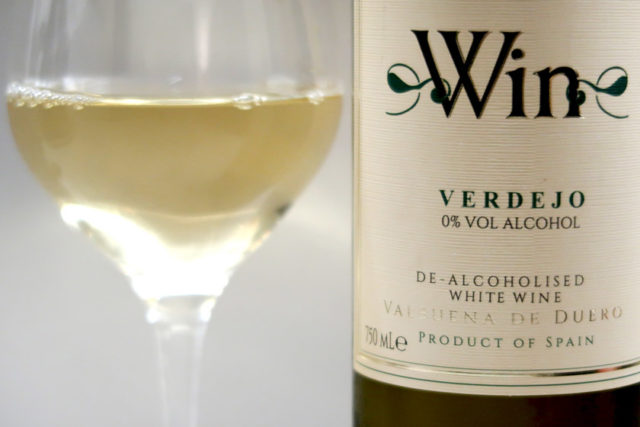
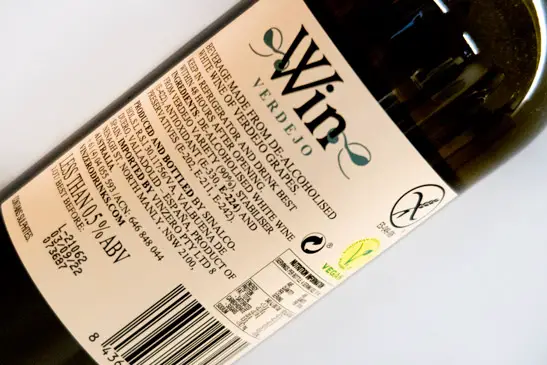
What is redisual Sugar
As you can see the below process of making non-alcoholic wine (and traditional wine for that matter) is based around removing sugar from the grape pulp by fermenting it into alcohol.
Now while most of the sugar in the grape pulp / grape juice is removed by fermentation, not all sugars are fermentable. This means there will always be a little sugar in each glass of wine and this will be the case whether you’re drinking alcoholic wine or non alcoholic wine.
Now that we know why there is sugar in our glass of wine, lets find out how it gets there. Time to look at how non alcoholic wine is created.
How is non alcoholic wine made 101
Non-alcoholic wine is usually made using alcoholic wine as a base and putting it through an extra step or process that leaves you with all the flavours and characteristics of wine and without the alcohol.
So what does a rough non-alcoholic winemaking process look like? I’ve done my best to simplify the process and not offend any winemakers in the process:
- Taking freshly picked grapes and crushing them – this breaks the skins, releases the juice and removes the stems creating a pulp;
- Adding yeast to and fermenting the crushed grape pulp – this turns the removes MOST of the sugars in the grape pulp by turning them into alcohol;
- Pressing off the fermented grape pulp and keeping only the alcoholic wine – this leaves you with a traditional wine that is ready to be aged, bottled or turned into non-alcoholic wine; and
- Putting the alcoholic wine through an alcohol removal process – this leaves you with non-alcoholic wine.
As wine making overview shows, the sugar in your glass comes from the grapes themselves and most of it is fermented out with (depending on what wine you’re drinking) only a small amount of it left.
But does non-alcoholic wine have more sugar than alcoholic wine? Find out below!
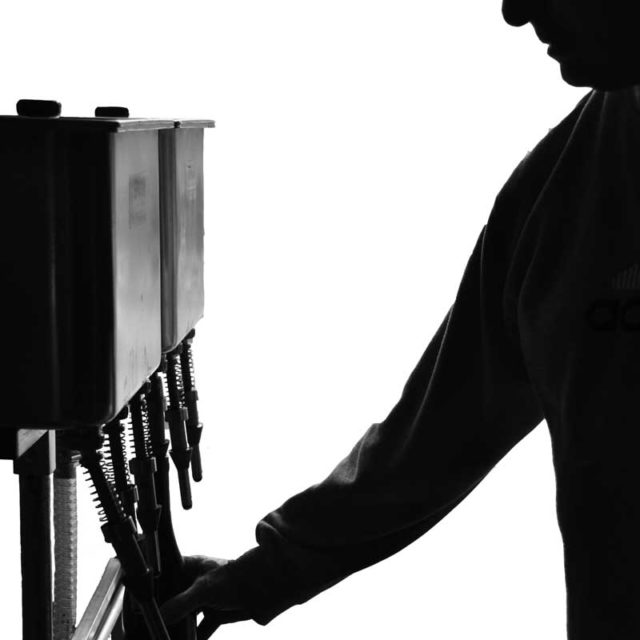
Does non-alcoholic wine have more sugar compared to alcoholic wine?
Like I touched on at the top of this post, non-alcoholic wine will often have a little more sugar in it when compared to alcoholic wine.
As a yardstick, alcoholic wines tend to ferment out most sugars and it is not uncommon to find less than 1.5 grams of sugar per glass of red or white wine.
Let’s focus on sugar in non-alcoholic wine but check out Wine Folly’s great research in this area for a more in-depth view on sugar in wine.
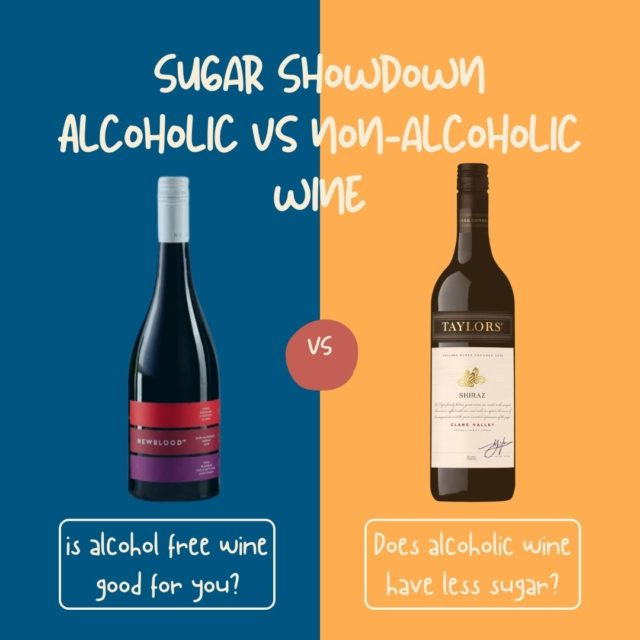
How do I know how much sugar is in my non-alcoholic wine?
The amount of sugar in each glass of non-alcoholic wine will depend on the type of wine you are drinking.
If you are indulging in a glass of slightly sweeter sparkling Rose (like the Vinada) you would expect it to naturally come with more sugar than a straight up and down Sauv Blanc (like the one by Giesen).
My tip to try and decipher sugar content on the run is to think about how your mouth feels after each sip and check in on what your mouth feels like.
If it is dry and tart, you’re likely to be dealing with a low sugar wine. On the other end of the spectrum, if you are left with that post juice box thickness in your saliva then you’re likely to be drinking a wine that brings a little more sugar to your glass.
Thankfully for all you Australian readers, as non-alcoholic wine in Australia is considered a food, you’ll find the sugar contents right there on the label for you.
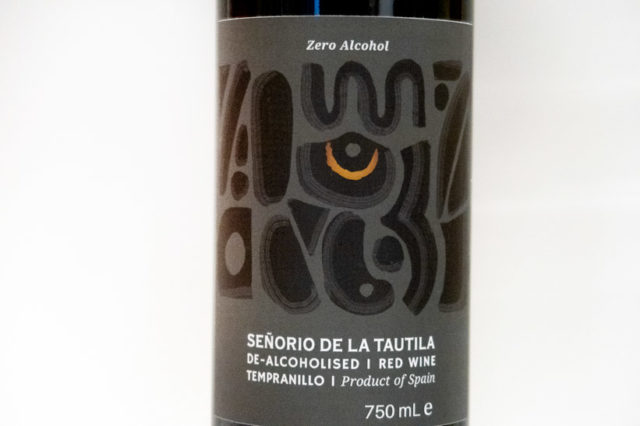
Is sugar in wine bad for me?
The inevitable question I had after learning about how sugar in non-alcholic wine was “is sugar in wine bad for me?”.
According to the World Health Organisation 50 grams of ‘free sugar’ per day is acceptable, however the American Heart Association, suggests no more than 24 grams of added sugar for women and 26 grams for men is required in the United States to slow the issues facing the population.
In short, sugar in wine is not bad for you rather the amount you consume is the most important piece. If you’re trying to:
- reduce calories or looking to lose weight, naturally consuming less is going to be better for you; and
- get as many calories in after a hard run, long ride or day of activity have that extra glass!
Hopefully this has helped you track down a wine that balances sugar and taste and given you a bit more insight into the world of sugar and non-alcoholic wine.
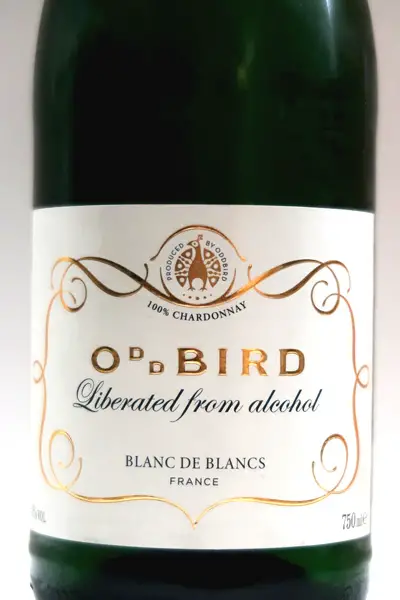
| Wine | Sugar / 100ml | Calories / 100ml |
| Newblood Chardonnay |
1.3 g / 100ml | 14 cals / 100ml |
| Giesen 0% Sauv Blanc |
1.8 g / 100ml | 13 cals / 100ml |
| Plus & Minus Rose |
1.9 g / 100ml | 22 cals / 100ml |
| New Blood Shiraz |
2.4 g / 100ml | 22 cals / 100ml |
| Thomson & Scott Noughty |
2.9 g / 100ml | 14 cals / 100ml |
| Edenvale Verdejo Sauvignon Blanc |
3.3 g / 100ml | 14 cals / 100ml |
| Lindermans Cabernet Sauvignon |
3.5 g / 100ml | 17 cals / 100ml |
| Carl Jung Shiraz |
3.5 g / 100ml | 17 cals / 100ml |
| Leitz Riesling |
3.8 g / 100ml | 17 cals / 100ml |
| Plus & Minus Pinot Grigio |
3.9 g / 100ml | 24 cals / 100m |
| Ara Wines Sauvignon Blanc |
3 g / 100ml | 18 cals / 100ml |
| Plus & Minus Blanc De Blancs Sparkling |
3 g / 100ml | 31 cals / 100ml |
| Odd Bird Organic Merlot / Shiraz |
4 g / 100ml | 18 cals / 100ml |
| McGuigan Zero Sauvignon Blanc |
4.2 g / 100ml | 22 cals / 100ml |
| Natureo Grenache Shiraz |
4.4 g / 100ml | 34cals / 100ml |
| Carl Jung Merlot |
4.5 g / 100ml | 22 cals / 100ml |
| Plus & Minus Shiraz |
4.5 g / 100ml | 29 cals / 100ml |
| Leitz Rose |
5.1 g / 100ml | 23 cals / 100ml |
| Baron & Guestier French Sparkling |
5.5 g / 100ml | 20 cals / 100ml |
| Vinada Sparling Rose |
5 g / 100ml | 18 cals / 100ml |
| Edenvale Premium Sparkling Shiraz |
6.1 g / 100ml | 38 cals / 100ml |
| Oddbird Blanc de Blancs Sparkling |
6.3 g / 100ml | 27.5 cals / 100ml |
